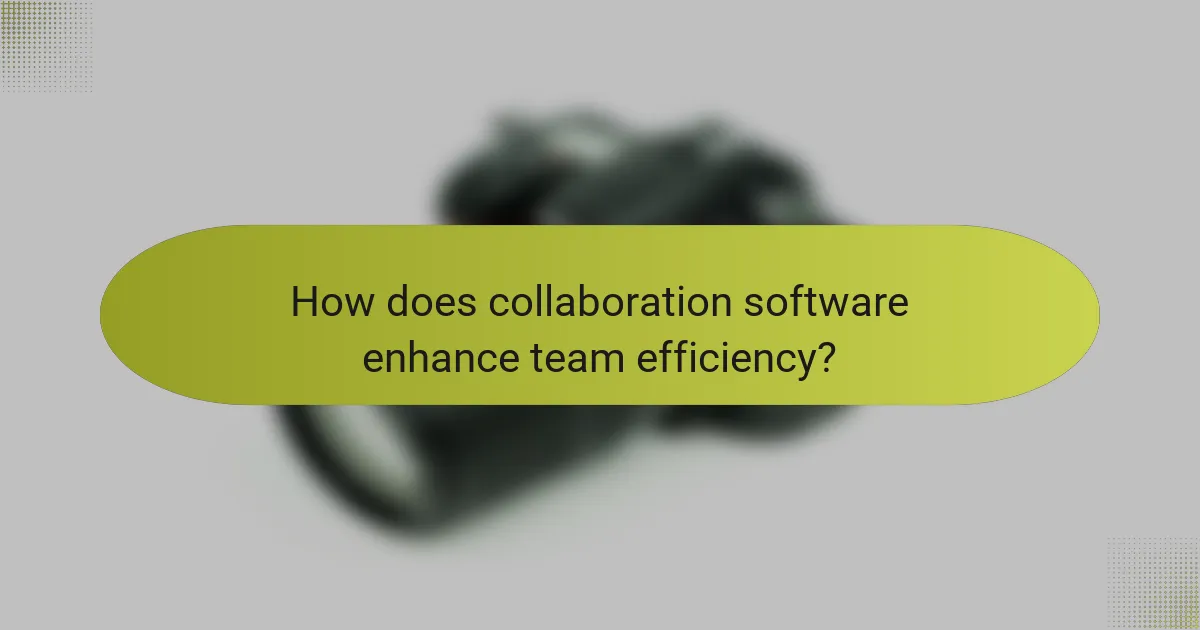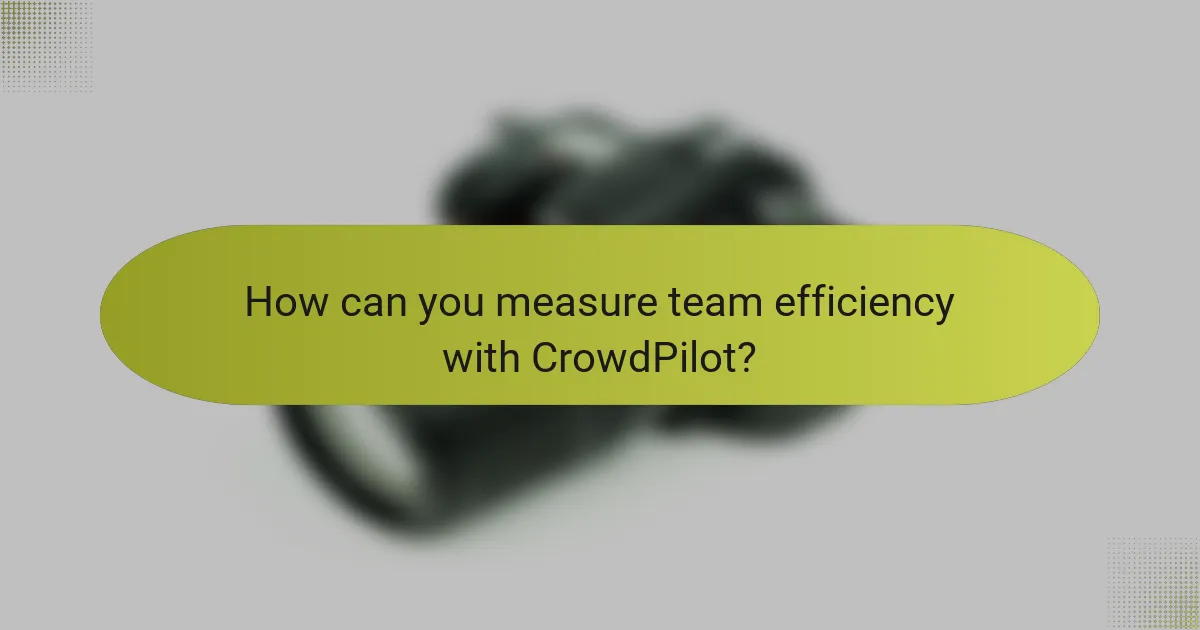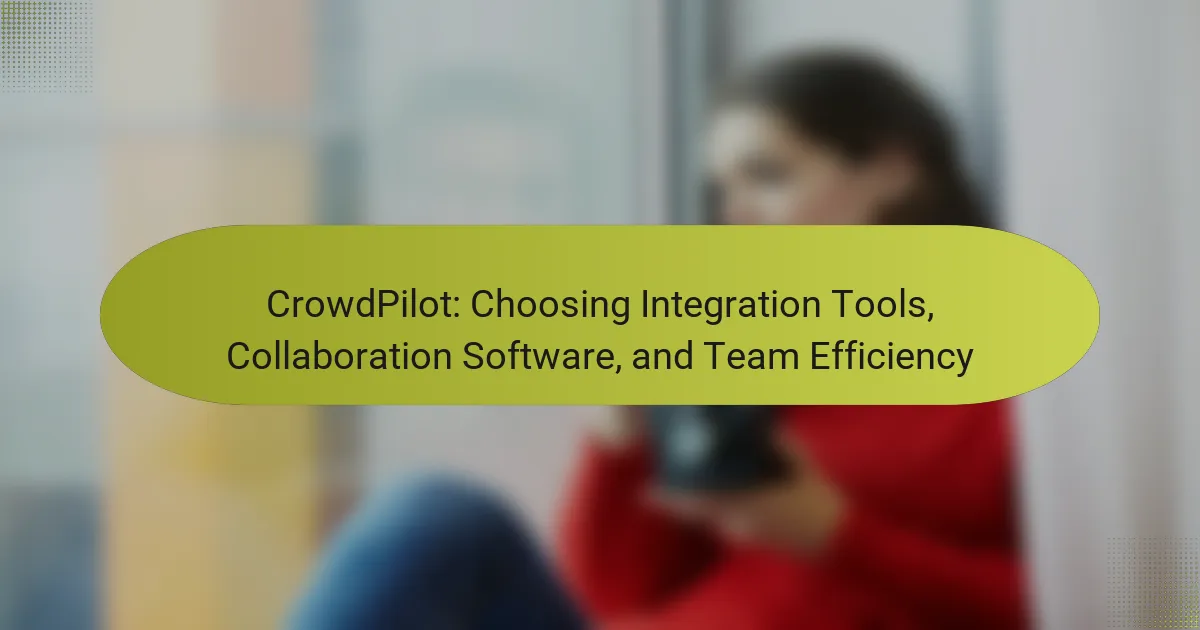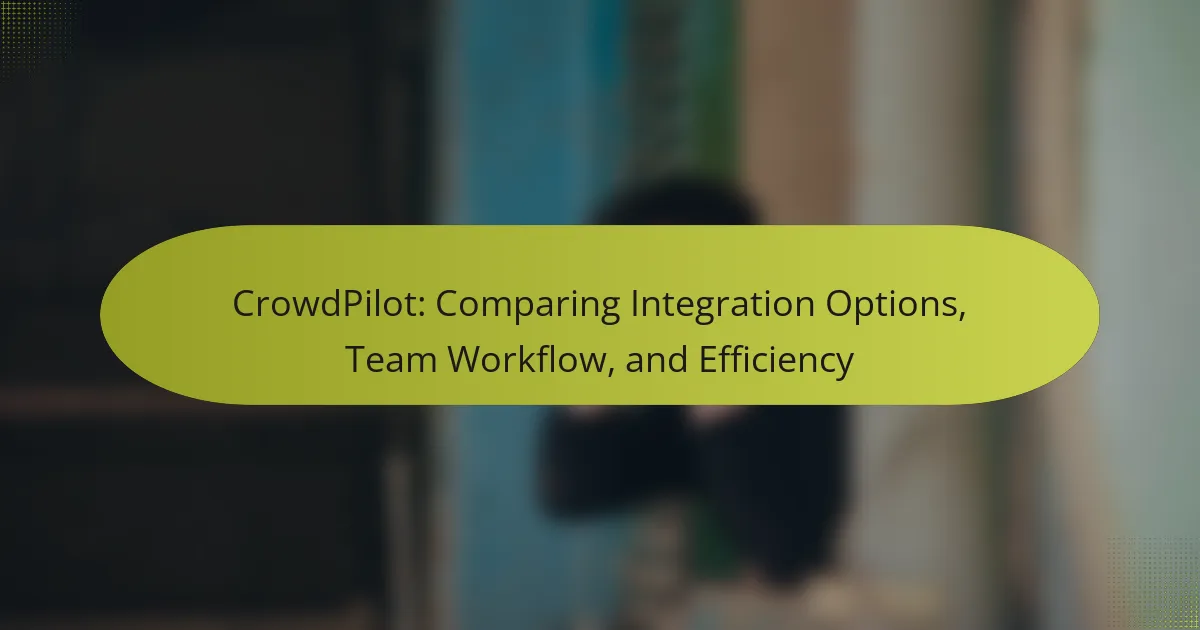CrowdPilot focuses on selecting the right integration tools and collaboration software to enhance team efficiency and streamline workflows. By automating processes and centralizing communication, these tools not only reduce manual tasks but also foster seamless collaboration among team members, ensuring alignment and productivity. When choosing software, it’s essential to consider user interface, integration capabilities, and the unique needs of your team.

What are the best integration tools for CrowdPilot?
The best integration tools for CrowdPilot enhance team collaboration by automating workflows and connecting various applications. These tools simplify processes, reduce manual tasks, and improve overall efficiency.
Zapier
Zapier is a popular integration tool that allows users to connect over 2,000 applications seamlessly. It operates on a trigger-action model, where an event in one app triggers an action in another, enabling automation of repetitive tasks.
For example, you can set up a Zap to automatically add new CrowdPilot tasks to your project management tool. This can save time and ensure that all team members are updated without manual input.
Integromat
Integromat, now known as Make, offers a visual interface for creating complex integrations between apps. It supports multi-step workflows, allowing for more intricate automation compared to simpler tools.
Consider using Integromat to pull data from CrowdPilot and send it to a reporting tool, generating insights without manual data entry. Its flexibility makes it suitable for teams with specific integration needs.
Microsoft Power Automate
Microsoft Power Automate is ideal for organizations already using Microsoft products. It integrates seamlessly with tools like SharePoint and Teams, making it easy to automate workflows within the Microsoft ecosystem.
For instance, you can automate notifications in Teams whenever a new task is created in CrowdPilot, ensuring that your team stays informed in real-time.
Tray.io
Tray.io is a powerful integration platform that caters to businesses needing advanced automation capabilities. It allows for custom workflows and offers a wide range of connectors to various applications.
Using Tray.io, you can create sophisticated integrations that pull data from CrowdPilot and push it to your CRM, enhancing data accuracy and saving time on manual updates.
Automate.io
Automate.io is user-friendly and designed for small to medium-sized businesses. It enables users to connect multiple apps and automate workflows with a straightforward drag-and-drop interface.
For example, you can set up Automate.io to sync CrowdPilot tasks with your email marketing platform, ensuring that your marketing team is always aligned with project updates.

How does collaboration software enhance team efficiency?
Collaboration software boosts team efficiency by streamlining communication, centralizing resources, and improving task management. These tools facilitate seamless interaction among team members, ensuring everyone stays aligned and productive.
Real-time communication
Real-time communication tools, such as chat applications and video conferencing, allow team members to connect instantly, regardless of location. This immediacy helps resolve issues quickly and fosters a collaborative environment.
When choosing a communication tool, consider features like message history, file sharing, and integration with other platforms. Popular options include Slack, Microsoft Teams, and Zoom, each offering unique functionalities to enhance team interaction.
Centralized document sharing
Centralized document sharing enables teams to store, access, and collaborate on files in one location. This reduces the risk of version control issues and ensures that all team members have the latest information at their fingertips.
Tools like Google Drive, Dropbox, and SharePoint provide easy access to documents while allowing for real-time editing. When implementing a document-sharing solution, prioritize security features and user permissions to protect sensitive information.
Task management features
Task management features help teams organize, prioritize, and track their work effectively. These tools allow for clear assignment of responsibilities, deadlines, and progress monitoring, which is essential for maintaining productivity.
Consider using platforms like Trello, Asana, or Monday.com, which offer visual boards and lists to manage tasks. When selecting a task management tool, ensure it integrates well with your existing collaboration software to streamline workflows and enhance overall efficiency.

Which collaboration software is ideal for remote teams?
The ideal collaboration software for remote teams enhances communication, project management, and overall productivity. Key factors to consider include user interface, integration capabilities, and specific team needs.
Slack
Slack is a messaging platform designed for team communication, offering channels for different topics, direct messaging, and file sharing. It integrates with numerous apps, making it easy to centralize workflows.
When using Slack, ensure to set clear guidelines for channel usage to avoid information overload. Regularly check notifications to stay updated without feeling overwhelmed.
Trello
Trello is a visual project management tool that uses boards, lists, and cards to organize tasks. This makes it easy for remote teams to track progress and assign responsibilities at a glance.
To maximize Trello’s effectiveness, use labels and due dates for better task prioritization. Regularly review boards in team meetings to keep everyone aligned on project status.
Asana
Asana is a robust project management software that allows teams to create tasks, set deadlines, and monitor project timelines. It offers various views, including lists and calendars, to suit different team preferences.
Utilize Asana’s templates for common projects to save time. Encourage team members to update task statuses frequently to maintain transparency and accountability.
Microsoft Teams
Microsoft Teams is a collaboration platform that combines chat, video conferencing, and file sharing within the Microsoft 365 ecosystem. It is particularly beneficial for teams already using Microsoft products.
To leverage Microsoft Teams effectively, integrate it with other Microsoft applications like OneNote and SharePoint. Schedule regular video calls to foster team cohesion and ensure everyone feels connected.

What criteria should you consider when choosing integration tools?
When selecting integration tools, consider factors such as ease of use, compatibility with existing software, and scalability. These criteria ensure that the tools you choose will enhance your team’s efficiency and collaboration without causing disruptions.
Ease of use
Ease of use is crucial for ensuring that team members can quickly adopt and effectively utilize integration tools. Look for intuitive interfaces and straightforward setup processes that minimize the learning curve. Tools that offer comprehensive documentation and customer support can further ease the transition.
Consider conducting trials or demos to assess usability. A tool that requires extensive training may hinder productivity, while one that is user-friendly can lead to faster implementation and better team engagement.
Compatibility with existing tools
Compatibility with your current software ecosystem is essential for seamless integration. Evaluate whether the integration tools can connect with your existing applications, such as project management software, CRM systems, or communication platforms. Tools that support widely used APIs or offer pre-built connectors can simplify this process.
Check for any potential conflicts or limitations that may arise when integrating new tools. Ensuring compatibility can prevent disruptions and enhance overall workflow efficiency.
Scalability
Scalability is important for accommodating future growth and changing needs. Choose integration tools that can easily adapt to increasing data volumes or additional users without sacrificing performance. Look for options that offer tiered pricing or features that can be unlocked as your organization expands.
Assess how well the tool can scale with your operations. A scalable solution not only supports current requirements but also prepares your team for future challenges, ensuring long-term value and efficiency.

How can you measure team efficiency with CrowdPilot?
Measuring team efficiency with CrowdPilot involves analyzing various performance indicators that reflect how well your team collaborates and completes tasks. By utilizing tools like performance metrics, feedback surveys, and time tracking, you can gain insights into productivity and areas for improvement.
Performance metrics
Performance metrics provide quantitative data on team output and effectiveness. Key indicators include project completion rates, the quality of deliverables, and adherence to deadlines. Regularly reviewing these metrics helps identify trends and areas needing attention.
Consider using a dashboard to visualize these metrics, making it easier to spot patterns over time. For example, if project completion rates drop below 70%, it may indicate a need for process adjustments or additional resources.
Feedback surveys
Feedback surveys are essential for gathering qualitative insights from team members about their experiences and challenges. These surveys can cover aspects like communication effectiveness, workload balance, and collaboration satisfaction. Regularly conducting surveys helps ensure that team members feel heard and valued.
To maximize the effectiveness of feedback surveys, keep them concise and focused. Aim for a mix of rating scales and open-ended questions to capture both quantitative and qualitative data. Analyzing this feedback can guide improvements in team dynamics and processes.
Time tracking
Time tracking allows teams to monitor how much time is spent on various tasks and projects. This data can reveal inefficiencies, such as excessive time on meetings or unclear task assignments. Implementing a time tracking tool can help teams allocate resources more effectively.
When using time tracking, set clear expectations on its purpose and ensure it is used to support, not micromanage. Aim for transparency; sharing time tracking results can foster accountability and encourage team members to optimize their workflows.

What are the emerging trends in collaboration software?
Emerging trends in collaboration software focus on enhancing remote teamwork, integrating artificial intelligence, and improving user experience. These trends aim to streamline communication, boost productivity, and foster a more connected work environment.
AI Integration in Collaboration Tools
AI integration is revolutionizing collaboration software by automating routine tasks and providing intelligent insights. Tools now leverage AI for features like smart scheduling, automated meeting notes, and real-time language translation, which can significantly enhance team efficiency.
When choosing tools with AI capabilities, consider how they can reduce manual workload and improve decision-making. Look for software that offers customizable AI features to fit your team’s specific needs.
Focus on User Experience
User experience (UX) is becoming a critical factor in collaboration software design. Intuitive interfaces and seamless navigation can greatly impact how effectively teams use these tools. Prioritizing UX helps minimize the learning curve and encourages adoption among team members.
To evaluate UX, consider conducting user testing or gathering feedback from team members. A tool that is easy to use can lead to higher engagement and better collaboration outcomes.
Remote Work and Hybrid Models
The shift towards remote and hybrid work models has driven the demand for robust collaboration software. Tools that facilitate virtual meetings, document sharing, and project management are essential for maintaining productivity across dispersed teams.
When selecting collaboration software, ensure it supports features like video conferencing, file sharing, and task tracking. Look for platforms that integrate well with existing tools to create a cohesive workflow.
Security and Compliance
As collaboration software becomes more prevalent, security and compliance are increasingly important. Organizations must ensure that their chosen tools adhere to data protection regulations and provide secure communication channels.
Evaluate software for features like end-to-end encryption, user authentication, and compliance with standards such as GDPR. This will help safeguard sensitive information while enabling effective collaboration.



